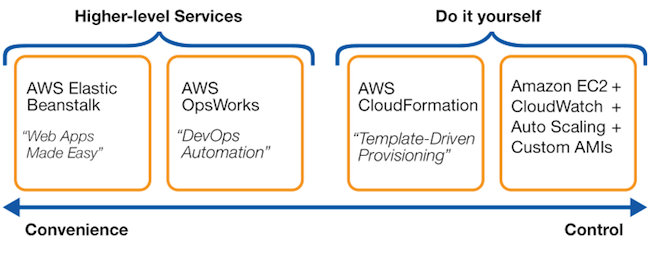What is the difference between Elastic Beanstalk and CloudFormation for a .NET project?
They're actually pretty different. Elastic Beanstalk is intended to make developers' lives easier. CloudFormation is intended to make systems engineers' lives easier.
Elastic Beanstalk is a PaaS-like layer ontop of AWS's IaaS services which abstracts away the underlying EC2 instances, Elastic Load Balancers, auto scaling groups, etc. This makes it a lot easier for developers, who don't want to be dealing with all the systems stuff, to get their application quickly deployed on AWS. It's very similar to other PaaS products such as Heroku, EngineYard, Google App Engine, etc. With Elastic Beanstalk, you don't need to understand how any of the underlying magic works.
CloudFormation, on the other hand, doesn't automatically do anything. It's simply a way to define all the resources needed for deployment in a huge JSON file. So a CloudFormation template might actually create two ElasticBeanstalk environments (production and staging), a couple of ElasticCache clusters, a DyanmoDB table, and then the proper DNS in Route53. I then upload this template to AWS, walk away, and 45 minutes later everything is ready and waiting. Since it's just a plain-text JSON file, I can stick it in my source control which provides a great way to version my application deployments. It also ensures that I have a repeatable, "known good" configuration that I can quickly deploy in a different region.
For getting started quickly deploying a standard .NET web-application, Elastic Beanstalk is the right service for you.

AWS CloudFormation: "Template-Driven Provisioning"
AWS CloudFormation gives developers and systems administrators an easy way to create and manage a collection of related AWS resources, provisioning and updating them in an orderly and predictable fashion.
CloudFormation (CFn) is a lightweight, low-level abstraction over existing AWS APIs. Using a static JSON/YAML template document, you declare a set of Resources (such as an EC2 instance or an S3 bucket) that correspond to CRUD operations on the AWS APIs.
When you create a CloudFormation stack, CloudFormation calls the corresponding APIs to create the associated Resources, and when you delete a stack, CloudFormation calls the corresponding APIs to delete them. Most (but not all) AWS APIs are supported.
AWS Elastic Beanstalk: "Web Apps Made Easy"
AWS Elastic Beanstalk is an easy-to-use service for deploying and scaling web applications and services developed with Java, .NET, PHP, Node.js, Python, Ruby, Go, and Docker on familiar servers such as Apache, Nginx, Passenger, and IIS.
You can simply upload your code and Elastic Beanstalk automatically handles the deployment, from capacity provisioning, load balancing, auto-scaling to application health monitoring.
Elastic Beanstalk (EB) is a higher-level, managed 'platform as a service' (PaaS) for hosting web applications, similar in scope to Heroku. Rather than deal with low-level AWS resources directly, EB provides a fully-managed platform where you create an application environment using a web interface, select which platform your application uses, create and upload a source bundle, and EB handles the rest.
Using EB, you get all sorts of built-in features for monitoring your application environment and deploying new versions of your application.
Under the hood, EB uses CloudFormation to create and manage the application's various AWS resources. You can customize and extend the default EB environment by adding CloudFormation Resources to an EB configuration file deployed with your application.
Conclusion
If your application is a standard web-tier application using one of Elastic Beanstalk's supported platforms, and you want easy-to-manage, highly-scalable hosting for your application, use Elastic Beanstalk.
If you:
- Want to manage all of your application's AWS resources directly;
- Want to manage or heavily customize your instance-provisioning or deployment process;
- Need to use an application platform not supported by Elastic Beanstalk; or
- Just don't want/need any of the higher-level Elastic Beanstalk features
then use CloudFormation directly and avoid the added configuration layer of Elastic Beanstalk.
Cloud Formation is a service that lets you deploy AWS services. You create a template file that describes which services you want. When you deploy that template, Cloud Formation creates the resources for you as a "package". All the resources you defined in your template are started and terminated together. Examples of types of resources that can be created with Cloud Formation are: S3, EC2 instances, AutoScaling, DynamoDb, etc. For EC2, Cloud Formation also gives you the ability to make use of "cfn-init" scripts; which can be used in conjunction with the template to boot strap your instances.
Elastic Beanstalk uses Cloud Formation templates and scipts to: 1. Create a Load Balancer and Auto Scaling Group, 2. Copy your code to S3, 3. Bootstrap an Ec2 instance to Download the code from S3 and deploy it.
Cloud Formation is not as easy to use as EB, but it is much more powerful, because you can create resources other than EC2 instances, control how the cfn-init script, and etc.